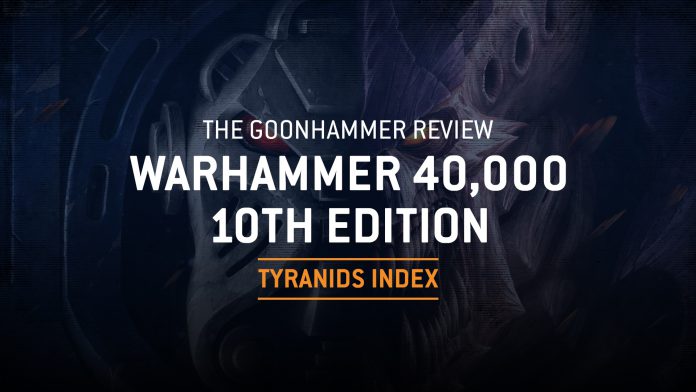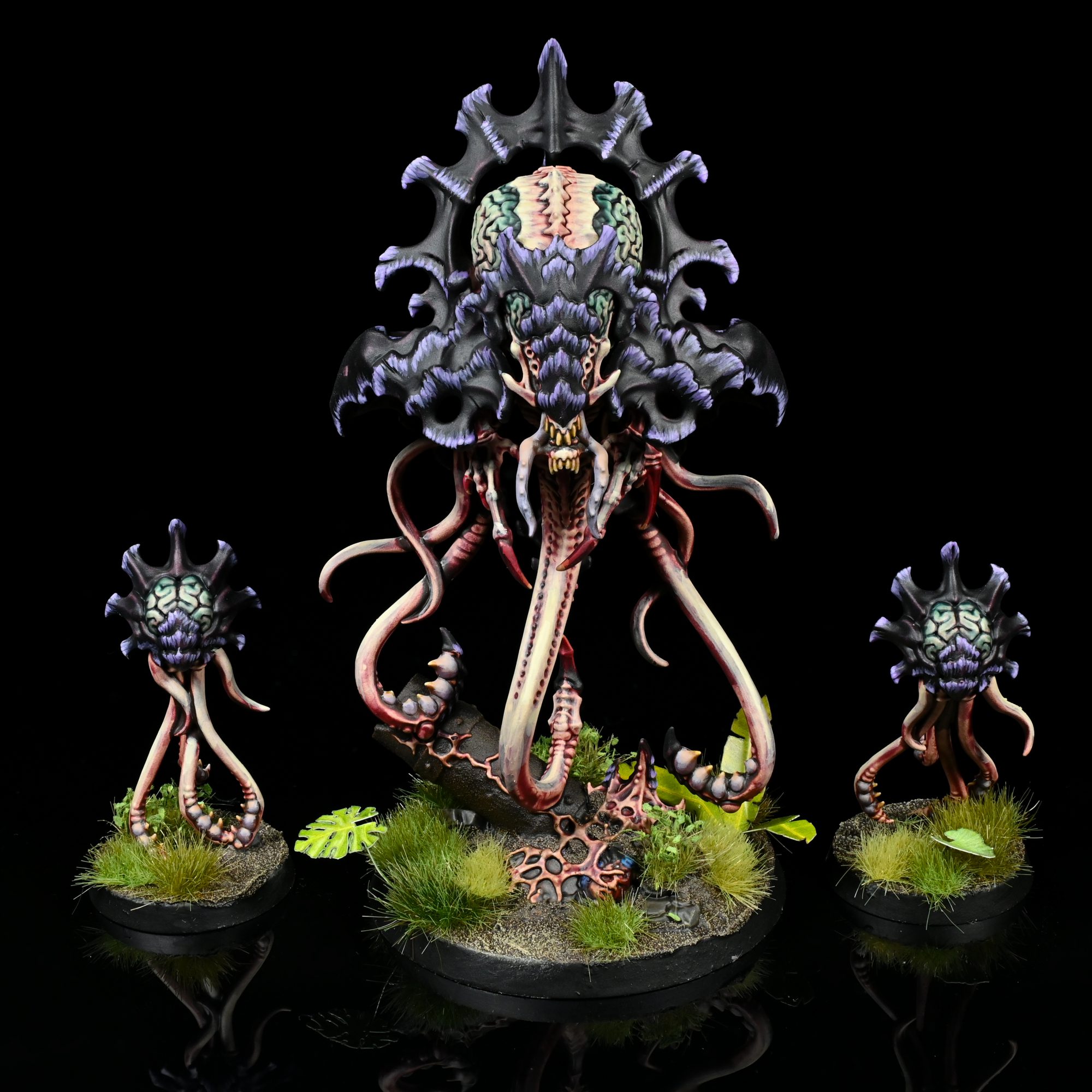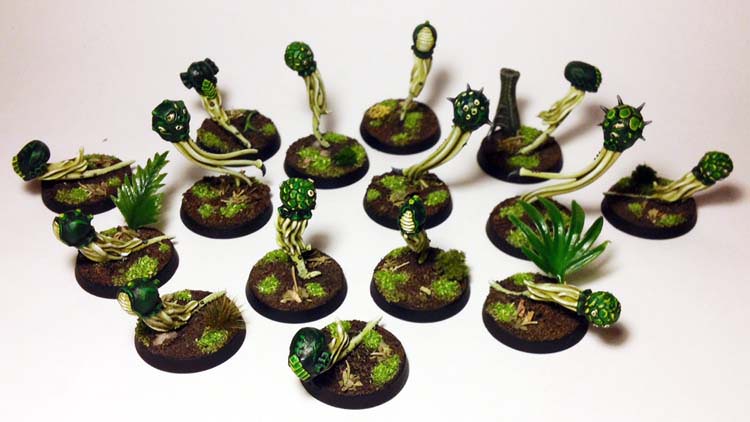The release of 10th Edition brings about a complete rewrite of every faction, and in this article we’ll cover how the Tyranids work. Games Workshop gave us a taste of what to expect in their Tyranid Faction Focus article, and we’re happy to report that the Hive Mind has a lot to be excited for. Whether your focus is on hordes of angry little bugs, a crushing stampede of huge angry bugs, or something in between, there’s something in here for you.
Before we begin we’d like to thank Games Workshop for providing us with a review copy of the Index for review purposes.
If you’d like to check out other parts of our 10th Edition coverage, you can find a landing page with links to all content here.
Army Rules
Many Tyranid abilities revolve around the new mechanic of Battle-shock, a core rule which reflects the panic and uncertainty of the battlefield. Normally players take a Battle-shock test in the Command phase for every unit which is Below Half-strength. If the 2D6 roll is less than the Leadership characteristic of the unit then they are Battle-shocked, which means they have an OC of 0 and cannot be affected by Stratagems. If you’re up against Tyranids, this is often made even worse, as plenty of their abilities either trigger when opponents fail a Battle-shock test nearby, or get better when targeting a Battle-shocked unit.
Tyranids take this theme further with their two faction rules. The first is Synapse, which reflects the will of the Hive Mind driving lesser creatures into a frenzy. When within Synapse range of a creature with the SYNAPSE keyword (typically 6” but some units increase this) the unit takes Battle-shock tests on a 3D6 instead of 2D6. Most Tyranid units have a Leadership characteristic of 8+, which will pass a Battle-shock test on 2D6 42% of the time. On a 3D6 that test is passed 84% of the time.
The second ability is Shadow in the Warp, which allows the player to unleash a once per battle effect that forces every enemy unit on the battlefield to take a Battle-shock test. This can be unleashed in either player’s Command phase so long as at least one unit in the army that’s on the battlefield has this ability. The decision as to when to force the Battle-shock test is important. Primary Missions are generally scored at the end of each Command phase, while Secondary Missions are scored at the end of each player’s turn. Because Battle-shock lasts until the start of the owning player’s Command phase, using Shadow in the Warp on your turn means the opponent can still score for the Primary Mission on their turn.
Detachment Rules
Tyranids have access to the Invasion Fleet Detachment, which provides access to the Hyper-Adaptations ability and several Enhancements. We expect that there will be other Detachments in the future which will include restrictions on what can be included, but in the case of an Invasion Fleet you can bring whatever you want.
Hyper-Adaptations
Invasion Fleets are characterized by a high level of flexibility, with the Hive Mind constantly evolving and adapting their forces to best counter the opposition. This is reflected in the game by having the Tyranid player select one of three options at the start of the first battle round. Every TYRANID model will gain an ability based on that option. If a player selects Swarming Instincts then all attacks against INFANTRY or SWARM targets gain the [SUSTAINED HITS 1] ability, meaning that on a Critical Hit the player adds an additional hit. Hyper-Aggression makes attacks that target MONSTER or VEHICLE units gain the [LETHAL HITS] ability, which allows Critical Hits to automatically wound the target. Finally selecting Hive Predators allows Critical Hits to gain the [PRECISION] ability, which enables them to target any CHARACTER models in the target unit. This is similar to options that some other factions have access to, but is distinct in that it lasts all game rather than providing one turn of each effect. It should make this Detachment very good at taking on skewed builds, particularly good if hulls end up as a big part of the early metagame.
Stratagems
Invasion Fleet Detachments get access to seven Stratagems, all of which complement the idea of flexibility. Many of the Stratagems can apply to one unit outside of Synapse Range or two units within, doubling their effectiveness and efficiency if you keep your army in good order. Players can use Stratagems to apply Feel No Pain to a target via Rapid Regeneration, threaten extra movement with Overrun, or dramatically heal ENDLESS MULTITUDE units with Endless Swarm. One Stratagem that will likely get a lot of use (although 2 CP is a pretty significant cost) is Adrenal Surge, which allows a unit to gain Critical Hits on a 5+. This synergizes extremely well with whatever Hyper-adaptation the player has selected, and can be made even more effective by spending an additional CP on Synaptic Insight to apply a second Hyper-adaptation to one or two units, particularly good for combining Sustained Hits and Precision into horde armies with good Leaders.
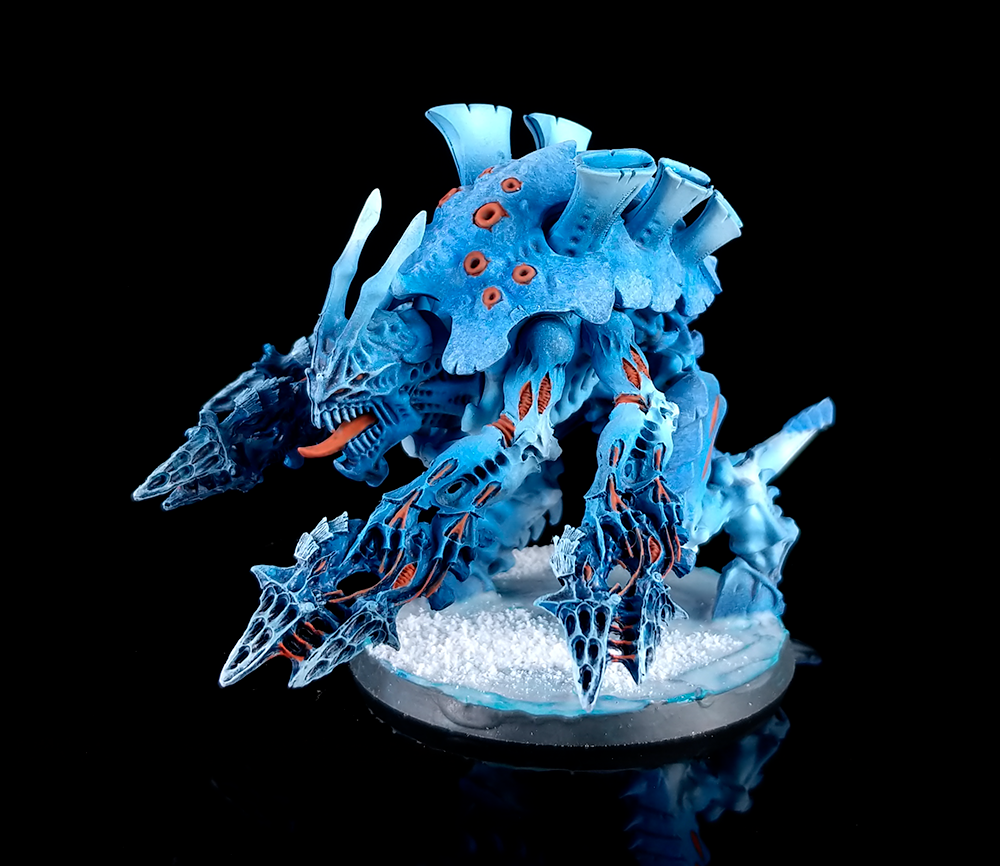
Enhancements
Enhancements replace the Relics and Warlord traits of 9th Edition, and are applicable to CHARACTER units which don’t have the EPIC HERO keyword. There are four options in the index. Sneaky players can use Alien Cunning to redeploy up to three units after both players have deployed their armies. Perfectionist players might want to use Perfectly Adapted to leverage one free re-roll per turn. Given the power of Synapse it might make sense to use Synaptic Linchpin to expand the Synapse Range of a model from 6” to 9”. Finally if a particular character is crucial to your force, you can use Adaptive Biology to apply Feel No Pain 5+ to the character (and it becomes Feel No Pain 4+ once it loses even a single wound). All of these abilities have a place and the optimal selection will likely depend on the composition of your army, although giving a Tervigon Feel No Pain feels like a massive boost.
Datasheets
The Tyranid Index contains most (but not all) of the models from the previous line. The most notable losses are character versions of the Trygon, Tyranid Warrior (although there’s a winged option) and the Zoanthrope; the Trygon Prime is just gone while the Neurothrope has been demoted to the Tyranid equivalent of a Sergeant. There are also several new units like the Psychphage and Neurotyrant. We covered them a bit in the Leviathan review but we’ll talk about them in the context of the rest of the army here.
One of the biggest faction-wide changes is how weapon strength has changed relative to the spectrum of target Toughness characteristics. Heavier threats are now in the T11 – T12 range, while the Strength characteristic of most Tyranid weapons hasn’t changed. Most of the heavy weapons carried by Tyranids like the venom cannon or Exocrine bioplasmic cannon are now more suited for killing heavy infantry since they will only wound tougher targets on a 5+. In terms of ranged attacks above at a Strength characteristic of 12 or higher you’re looking at the Tyrannofex rupture cannon or Zoanthrope focused warp blast, although the Hive Guard shockcannon is ANTI-VEHICLE 2+. Against armies heavy on big targets, Hyper-Aggression is definitely your friend!
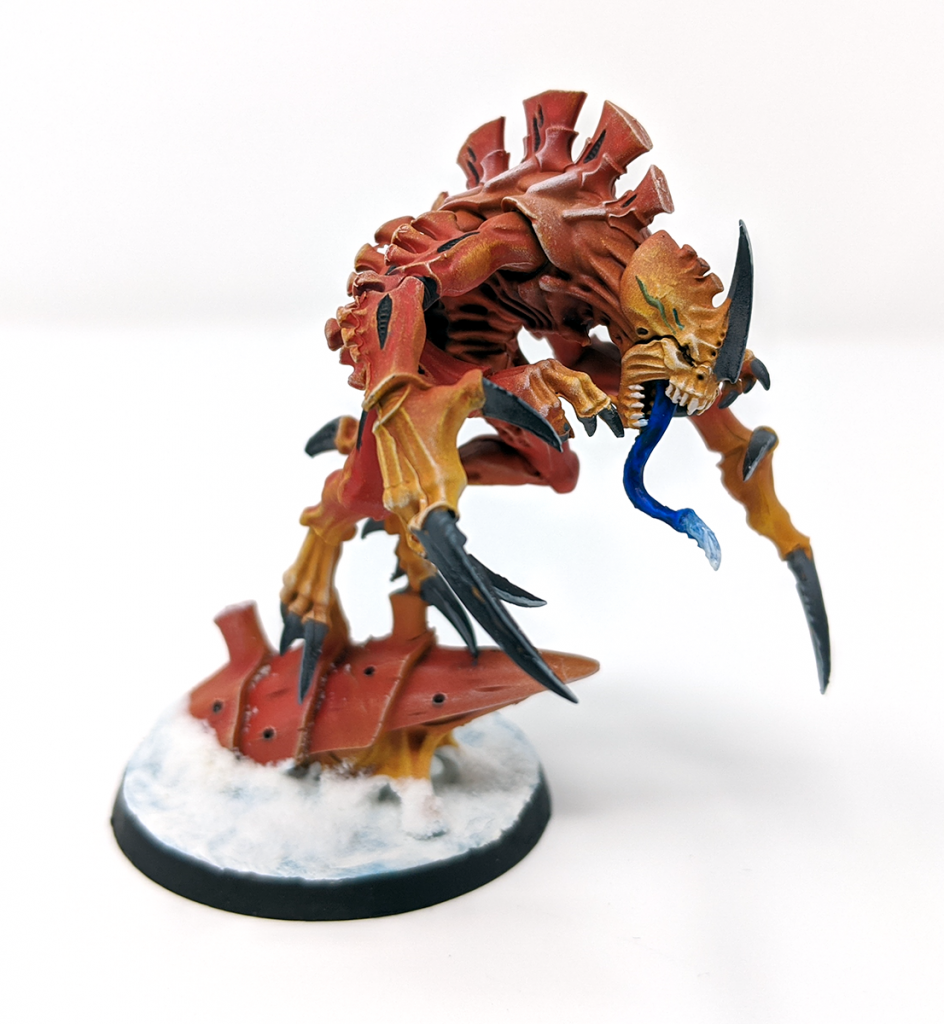
Characters and Related Units
Every army is required to have a CHARACTER unit to serve as the Warlord, which makes at least one of these units mandatory.
- The Swarmlord and Hive Tyrants are still around and will provide Synapse coverage. The Swarmlord provides an extra CP per turn and can also force an enemy Stratagem to be more expensive, while the Hive Tyrant and Winged Hive Tyrant allow a unit within 12” to use a Stratagem for free. The Swarmlord and regular Hive Tyrant can hide in a unit of Tyrant Guard, while the T9 Winged Hive Tyrant is completely exposed. The Swarmlord only has a dedicated melee attack, while the Tyrant options have both ranged or melee options which are generally good at either killing chaff or targets at T9 or less.
- The Neurotyrant is a new dedicated support unit that can be embedded in a unit of Neurogants or Tyrant Guard. One would think the giant floating brain bug would want to lead a unit of Zoanthropes, but apparently not. The unit it leads gains +1 to hit all the time and +1 to wound against Battle-shocked targets, and if a Neurotyrant is on the table when Shadow of the Warp is unleashed then every Battle-shock test is at a -1 penalty. It also has a Command phase ability to provide Synapse coverage to two units within 12” that lasts until the next Command phase.
- The Tervigon is a T11 MONSTER that is intended to support nearby units of Termagants. Termagant units within 6” gain the [LETHAL HITS] keyword on their attacks, and up to D3+3 destroyed Termagant models can be restored to a nearby unit each turn. It’s no slouch in melee either, and can either be armed with S12 crushing claws or scything talons which are viable against light vehicles or elite infantry.
- Old One Eye is still around as an EPIC HERO CHARACTER, and as usual it is an absolute wrecking ball. At T9 with a 2+ save and Feel No Pain 5+ it’s fairly hard to kill (plus it regenerates D3 wounds each player’s Command phase). In melee it has profiles that will either murder heavy targets or chaff, and hit rolls in any unit it leads can be re-rolled. OOE leading a pair of Carnifexes seems like a particularly nasty threat to put down on the table.
- The Winged Tyranid Prime is the only Tyranid Prime option available. It can be attached to units of Tyranid Warriors or Gargoyles, and it gives weapons in that unit the [SUSTAINED HITS 1] ability. It also has a chance to fight after death, which isn’t terribly exciting because its melee attacks are pretty milquetoast.
- Deathleaper is an EPIC HERO CHARACTER which means it can’t receive Enhancements, but what it can do is always Fight First and not be targeted by attacks more than 12” away thanks to LONE OPERATIVE. All Lictor units gain 1 CP whenever they destroy an enemy CHARACTER model, and Deathleaper is so terrifying that the Leadership characteristic of enemy units within 6” is reduced by 1. If a nearby enemy unit is below their Starting Strength then in their Command phase they will also be forced to take a Battle-shock test. The regular Lictor is far less appealing and has none of the Leadership alterations or Battle-shock effects of the epic version, and is not a CHARACTER.
- The Parasite of Mortrex is a CHARACTER with FLY who has DEEP STRIKE, LONE OPERATIVE, and STEALTH. This means they’re fast and hard to shoot. In melee they can potentially spawn Ripper Swarms if an enemy INFANTRY model is killed by the Parasite’s barbed ovipositor, and one enemy unit in Engagement Range will be forced to take a Battle-shock test courtesy of excessive itching.
- The Broodlord is clearly designed to lead Genestealers and not much else. It inexplicably doesn’t have SYNAPSE, but it will provide [DEVASTATING WOUNDS] to the unit of Genestealers it leads and one enemy unit within Engagement Range will be at -1 to hit in the Fight phase.
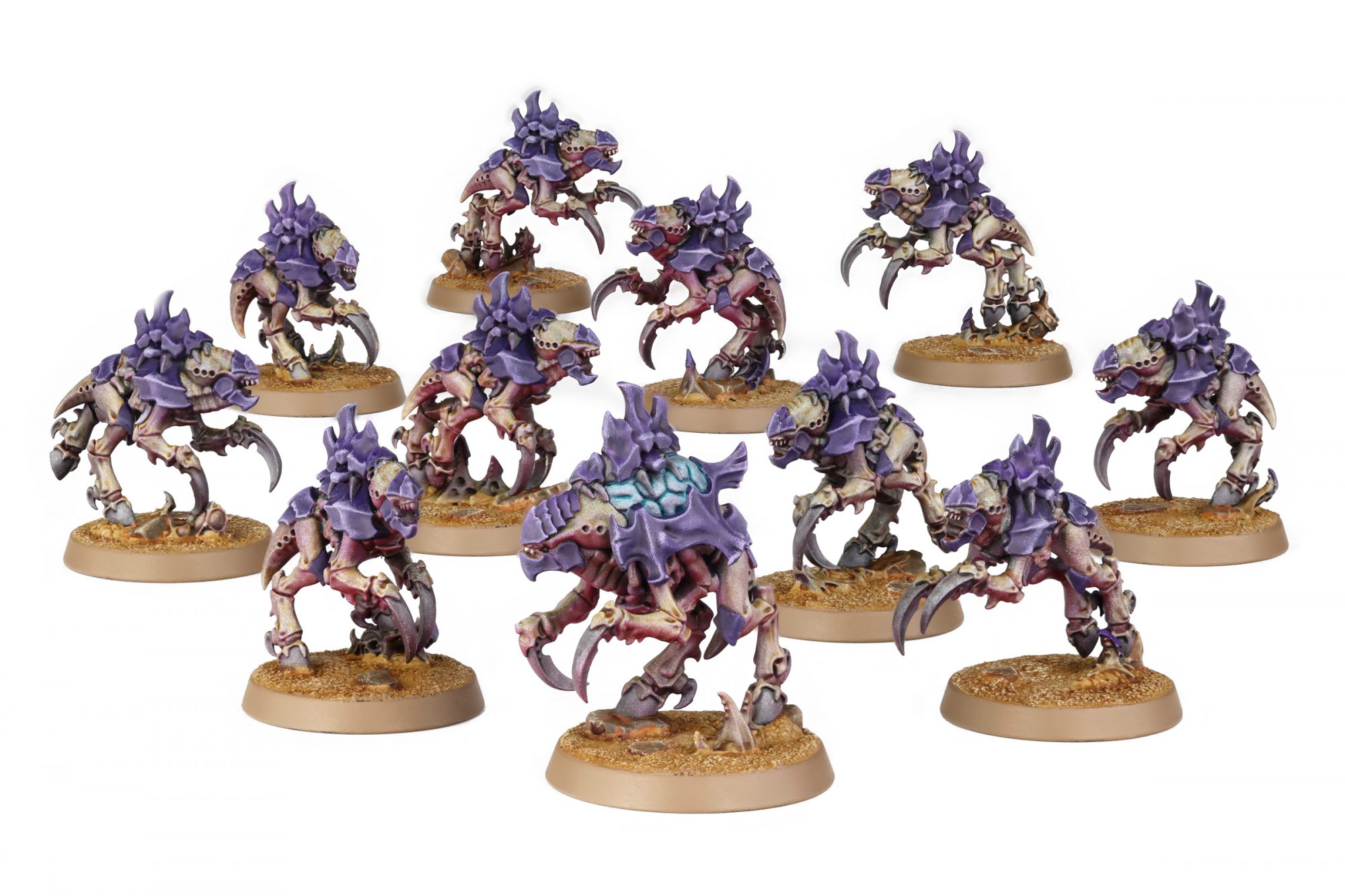
Endless Multitudes
If players want to play a seething mass of bodies then they have four options to choose from. All of these units are single wound models which can be reinforced by the Endless Swarm Stratagem. In contrast to 9th Edition, the maximum model count of these units has been capped at 20, so they’re slightly less swarm-tastic, but washing over people with a horde of gribblies is very much still available as a plan.
- Termagants are happy to swarm over objectives with their new models and an OC characteristic of 2. There are three weapon options, with the best probably being a spinefist since the profile has [ASSAULT] and [TWIN-LINKED] with 2 attacks. None of these guns are going to do much against anything outside of unarmored infantry.
- Hormagaunts are purely melee creatures with 3 attacks and the ability to Advance and Charge. With a 10” move and an OC of 2 they’re also good for moving quickly across the field and either blocking the enemy’s movement or contesting objectives through sheer bodies.
- Gargoyles are incredibly speedy, with a 12” move, FLY, and the ability to make a Normal move of up to 6” after they shoot (at the expense of not being able to charge). Since their fleshborers have the [ASSAULT] keyword they can do all of this and advance, meaning they can go an average of 21” in a turn. Like Hormagaunts and Termagants they have an OC of 2, but their Save characteristic is a 6+ so they’ll die even faster to concentrated fire.
- The new models are the Neurogaunts, and to be honest we’re not sure what their purpose is. The T3/6+ profile is easy to kill, the 6” move makes them far slower than the other swarming options, they are only OC 1, and their primary ability is to serve as a Synapse creature when they’re in Synapse Range.
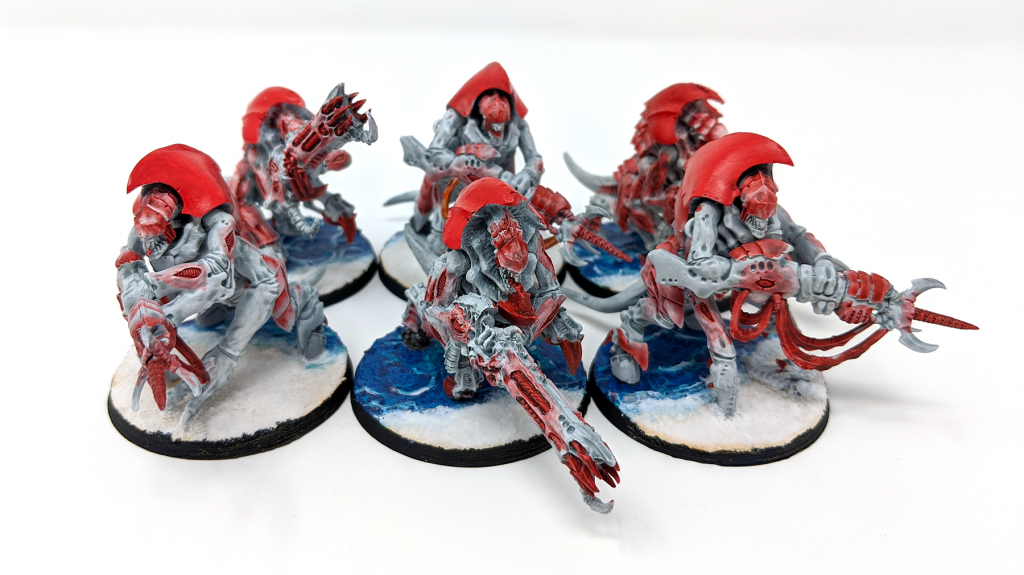
Multi-Wound Infantry
Tyranids have access to a large number of multi-wound INFANTRY options, some of which are incredibly strong. Expect to see at least some of these units in any list.
- Tyrant Guard are T8 and provide Feel No Pain 5+ to any model leading them. Their melee options are generally designed for killing elite infantry or chaff, although with the support of a Neurotyrant they could potentially threaten something a bit tougher. The bone cleaver and lash whip seem to be the most generally useful thanks to the [TWIN-LINKED] ability.
- Zoanthropes look extremely effective. Featuring a 4+ invulnerable save and an aura that provides a 6+ invulnerable to nearby units, they have a flexible psychic shooting attack which is good against chaff or heavy targets. When a nearby unit fails a Battle-shock test they can not only inflict mortal wounds on the enemy, but also heal themselves.
- Barbgaunts are 2 wound T4 INFANTRY armed with bio-cannons, a 24” range weapon that gets D6 BS 4+ shots that have the [BLAST] and [HEAVY] keywords. What sets these units apart is the special ability detailed in Warhammer Community; enemy INFANTRY units that are hit by an attack from this unit take a 2” penalty on their Movement characteristic as well as Advance and Charge rolls. There’s no limitation on how many can be affected at once, so hopefully this will get an early errata.
- Venomthropes are an interesting support choice. They provide the Benefit of Cover to all units (including MONSTERS) within 6”, and also grant STEALTH to nearby non-MONSTER units. Depending on the composition of your army these might be a useful tool.
- Hive Guard are now significantly tougher at T7, but their weapon options took a huge hit. Impaler cannons still have [INDIRECT FIRE], but the profile only does a single point of damage. Against vehicle targets players might be tempted to take Shockcannons, as the 2 attacks have [ANTI-VEHICLE 2+], but the limited AP and low-ish damage makes it difficult to take these when other options are more lethal.
- Tyranid Warriors come in two varieties; ranged and melee. For ranged units the deathspitter is likely the best option with one or two venom cannons added for a bit of firepower against tougher targets. Their special ability is to fall back and shoot. Melee units only have one profile which has a decent number of attacks and is [TWIN-LINKED], and their unique ability is a choice between re-rolling ones in hit rolls or save rolls (but only for the duration of the Fight phase).
- Von Ryan’s Leapers are fast, always Fight First, Infiltrate, and can use the Heroic Intervention Stratagem for free. Their attacks are designed to clear out chaff and might do some damage against tougher targets through sheer volume.
- Raveners can Deep Strike and have an ability to enter Reserves at the end of the opponent’s turn if there are no enemies in Engagement Range. They have a profile that’s similar to Von Ryan’s Leapers in that they can puree chaff with a huge number of attacks.
- Genestealers have two wounds and keep their 5+ invulnerable save for a bit of survivability. They can re-roll wound rolls of 1 (or any wound roll when near an objective marker), but their S4 AP -2 D1 attacks are pretty mediocre. As with the Broodlord they get an 8” Scout move at the beginning of the game.
- Pyrovores are still around with a 12” range [TORRENT] attack that ignores cover and prevents one enemy unit that was hit from benefiting from cover for the rest of the Shooting phase. Unfortunately these units suffer from a ridiculously slow 5” Movement characteristic, which means by the time they are actually within range they won’t be needed.
- Ripper Swarms suck. They’re T2, have no Objective Control, and their only benefit is that they half the OC characteristic of units in Engagement Range.
- Biovores are slow, but they don’t care because they have a shooting attack with a 48” range and the [INDIRECT] keyword. Alternatively you can use them to seed Spore Mines throughout the battlefield, dropping a unit consisting of one Spore Mine for every Biovore. This can also be done using the Overwatch Stratagem, which seems to be ideal for making your opponent’s life miserable. It also makes them exceptionally good (perhaps even *too* good) at scoring some secondary objectives.
Spores and Pods
It wouldn’t be a Tyranid army without a variety of slowly floating bags of pressurized death threatening to inflict mortal wounds on your enemies. Depending on how GW decides to FAQ things spore mines could either be game breaking or just another novelty.
- The basic Spore Mine can Deep Strike and has a Movement characteristic of 4”. With an OC of 0 the purpose of this unit is to get within 3” of the enemy and explode. When it does you roll a D6. On a 2-5 the enemy takes 1 mortal wound, and on a 6 it takes D3. They also prevent enemies within 6″ from starting or ending an Advance move.
- Mucolid Spores also move 4” and have Deep Strike, and also prevent enemy units from starting or ending an Advance move within 6”. When they detonate a D6 roll of 2-5 inflicts D3 mortal wounds and a 6 inflicts D6 mortal wounds.
- Sporocysts are T10, have 10 wounds with a 3+ save profile, and have an OC characteristic of 0. What they do have is potentially the most insanely game breaking combination of abilities we can think of. When a Sporocyst shoots they can instead choose to create a Mucolid Spore anywhere within 18” but more than 9” away from an enemy. The insane part is that they have an ability which allows them to shoot (up to four times) as if it were their Shooting Phase when an enemy ends a Normal, Advance, or Fall Back move within 24” of the unit. This means they could theoretically spawn up to 4 Mucolid Spores per enemy turn, unless out-of-phase rules work differently than in 9th (there’s nothing in the core rules about them this time). Hopefully this gets clarified soon.
- The Tyrannocyte can carry up to 20 INFANTRY or one MONSTER with a Wounds characteristic of 12 wounds or less. Infantry models with more wounds take up the space of 3 models, so you can either carry 20 Termagaunts or 6 Zoanthropes. Regardless of any mission rules the unit can be set up in the first, second, or third turn. Once set up the embarked units must immediately disembark and cannot be set up within 9” of an enemy unit.The Tyrannocyte itself does have an OC 2 so you could potentially use it to deploy and then sit on a marker.
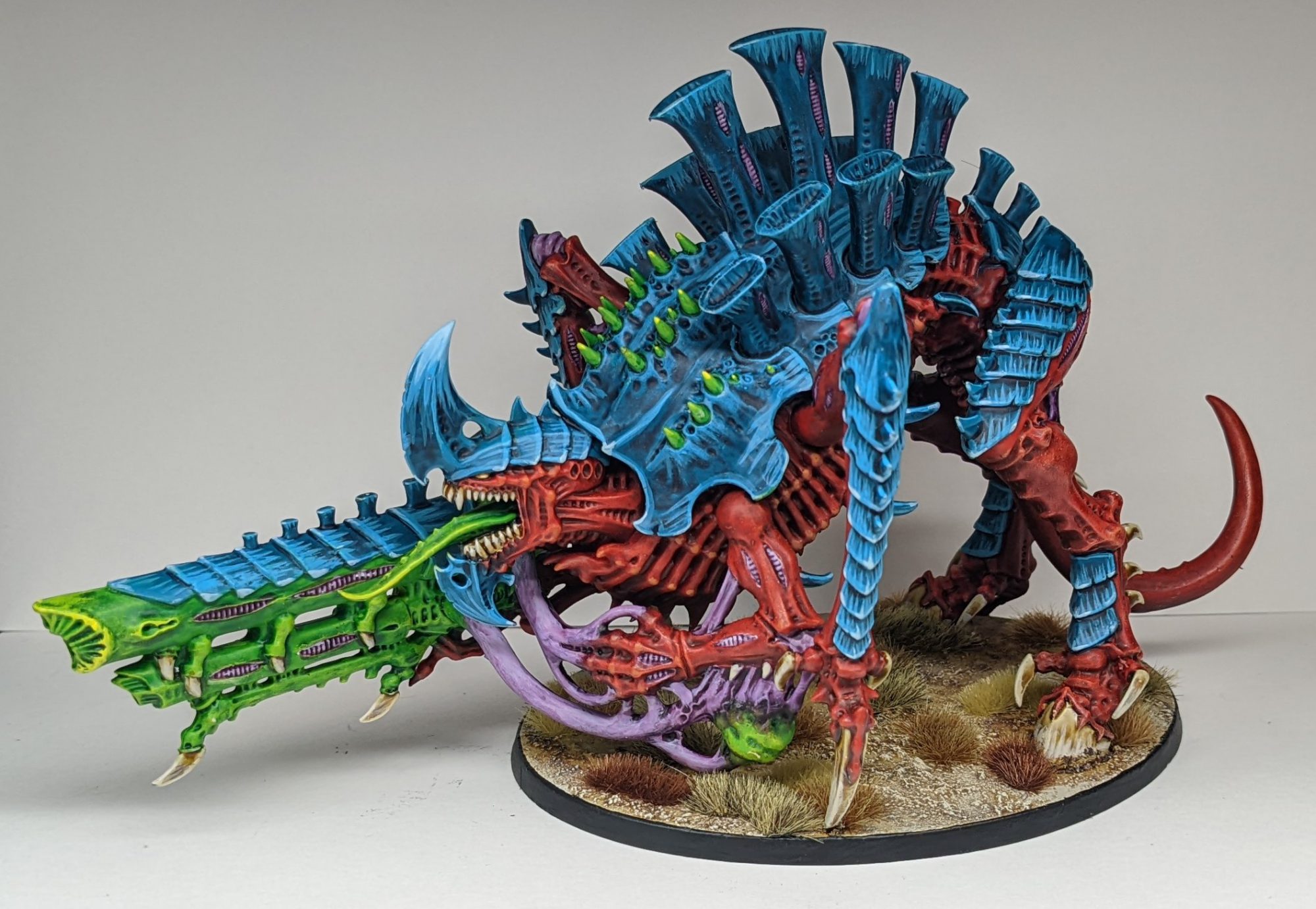
Monsters
Finally we have the big bugs, and given how Toughness and Strength have expanded it seems like these have the potential to be a major part of any army.
- The Haruspex is a big winner this edition, featuring a high Toughness characteristic, loads of attacks and a bunch of wounds. It’s purely melee and features a nasty combination of anti-heavy and anti-elite that will be useful in a lot of situations. If it destroys an enemy unit then nearby units must take a Battle-shock test.
- Maleceptors maintain their role as big Synapse Psyker bugs. Their melee is suited for elite threats, but their combination of a 4++ and an aura that reduces enemy hit and wound rolls seems very useful.
- The Tyrannofex is the toughest unit in the index and adds damage reduction to make it even harder to kill. It has three gun options including the anti-heavy weapon shown by the WarCom faction focus, the acid spray for killing elites, and a high shot weapon for clearing chaff.
- The Exocrine remains a dedicated gun bug, with a large gun suitable for killing elite targets. When it hits a unit other units that shoot at the same target can re-roll hit rolls of 1.
- Toxicrenes are extremely deadly against INFANTRY targets, with a large number of [ANTI-INFANTRY 2+] attacks in both melee and at range. It can also force units in Engagement Range to Remain Stationary instead of Fall Back on a 3+, and nearby enemy units will take mortal wounds thanks to an aura ability.
- The Carnifex has had some interesting changes. It’s highly mobile with an 8″ move and an ability which has them move closer to the enemy if they get wounded. They have the same options as before, and having two melee Carnifexes led by Old One Eye seems like a great wrecking ball. It’s worth noting though they’re less accurate in melee, now hitting on a 4+ but Old One Eye helps them mitigate that.
- The Screamer-Killer received a new model in Leviathan, and is separate from the Carnifex. It’s excellent against elite targets, and it can use its death scream ability to force a Battle-shock test with a -1 penalty.
- The Psychophage is from the new Leviathan box set and it’s a relatively weak (T9) support unit that provides a 6+ Feel No Pain aura. In melee its attacks are designed to kill psykers with a combination of [DEVASTATING WOUNDS] and [ANTI-PSKER 2+].
- Mawlocs are T10 and are deadly when they erupt from the ground, forcing every enemy unit in 12″ to potentially take mortal wounds and force a Battle-shock test on a 5+.
- Trygons have lost the Prime version, but have a melee profile which can hit hard against elite targets. It can Deep Strike within 3″ of enemy units, but cannot charge if it does so.
- The Hive Crone has the FLY and AIRCRAFT keywords. Its ranged attacks include one weapon with [ANTI-VEHICLE 4+] and [DEVASTATING WOUNDS], and it gets a bonus to hit targets with FLY.
- The Harpy is still the other flyer, and at range it is effective against elite threats. It can perform bombing runs or deploy D3 Spore Mines at the end of a Normal Move.
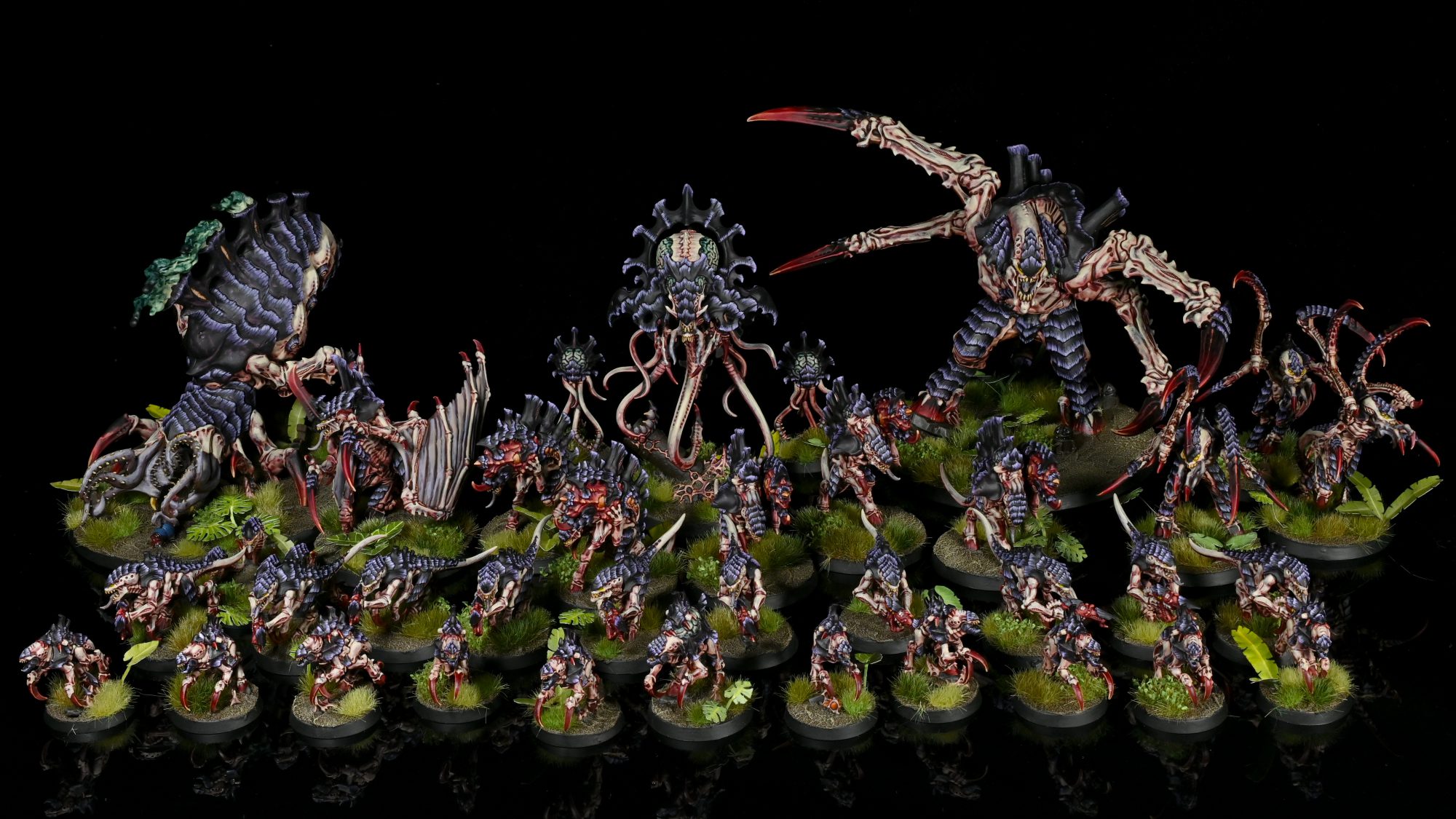
Five Coolest Units
- Haruspex – Finally, the lowly Haruspex gets its moment to shine. 18 melee attacks, four of which hit as hard as a Heavy Laser Destroyer. What’s not to like?
- Zoanthropes – They look like they will be a major part of any Tyranid force. They have a flexible shooting attack, provide an invulnerable save aura, and are Synapse. The only way they could be cooler is if the Neurotyrant could lead them.
- Maleceptors – While not the most lethal, they can hold their own and provide a lot of synergy thanks to their Synapse aura and the enemy degradation.
- Neurotyrant – These big brains are probably more cool than they are good, but having a bonus for Shadow of the Warp is nice.
- Psychophage – Devastating against psykers and offering a Feel No Pain aura, these guys are a useful addition to any army.
Five Biggest Changes from 9th
- Tyranids don’t have a lot of high strength attacks, so expect to see a healthy number of units which provide that option. Notably Haruspexes, Zoanthropes, and Tyrannofexes.
- The army heavily emphasizes synergistic effects, like stacking the bonuses from a Psychophage and Maleceptor to make things harder to kill.
- The Battle Shock mechanic is a core part of how this army plays, featuring lots of opportunities to force a Battle Shock test and several consequences for failure.
- With access to a lot of high Toughness units, this army will definitely pose a challenge if opponents are lacking in firepower.
- Synapse is very powerful, helping both against Battle Shock and providing a bonus for certain Stratagems.
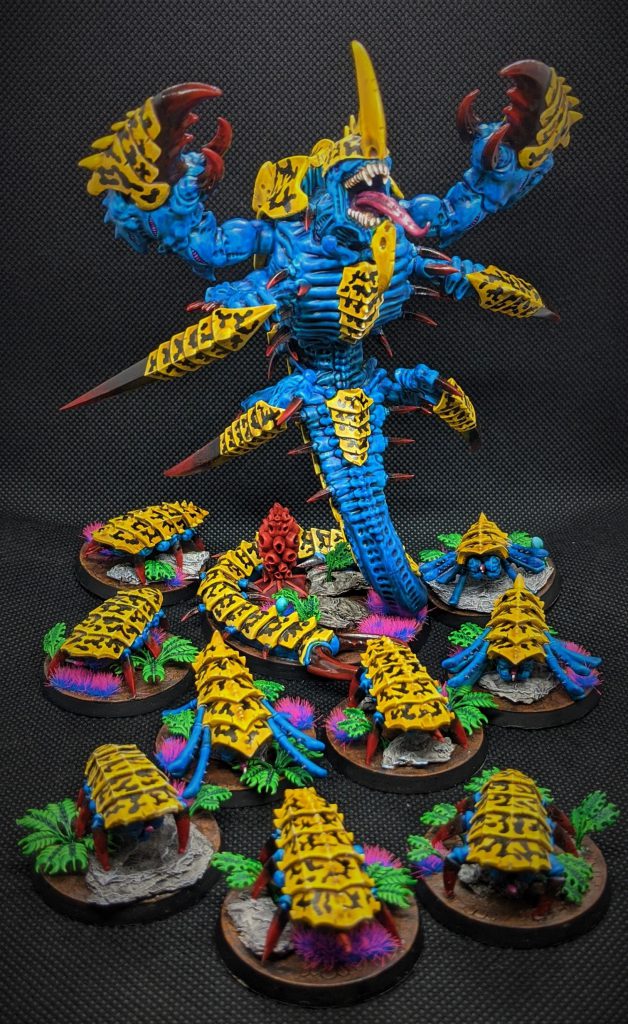
What Makes the Faction Look Cool?
There’s a lot to like here. The Battle-shock mechanics look like they could be a lot of fun, and the way that Tyranid units synergize and support each other opens up a lot of potential. Your opponent could find themselves facing a lot of very large, very hungry, very nasty bugs and not be sure what to kill. Do you kill the Haruspex that will slaughter you if it gets too close? Or do you take out the Zoanthropes and Psycophage that’s protecting it? What about the Maleceptor? Or that pack of Carnifexes that gets closer every turn you shoot at it? Revel in the horror of your opponent’s calamity before you overrun them in a gnashing pile of teeth and claws. Beyond that, what makes the faction look cool are the sheer number of ways you can customize and paint this army. Whether your preferred style is bright and cheerful or grim and dark, anything and everything looks good when it’s on a bug the size of a tank.
Wrap Up
We’re all extremely excited for 10th Edition, and our initial impression is that Tyranids will be a faction that will be fun to play and a challenge to face. While some things could potentially be problematic (notably Sporocysts), we would hope that the most egregious issues would be errata’d and what’s left will be competitive and fun. The other thing to consider are the points; while many of these units look powerful and fun, their viability will be entirely dependent on their final cost.
